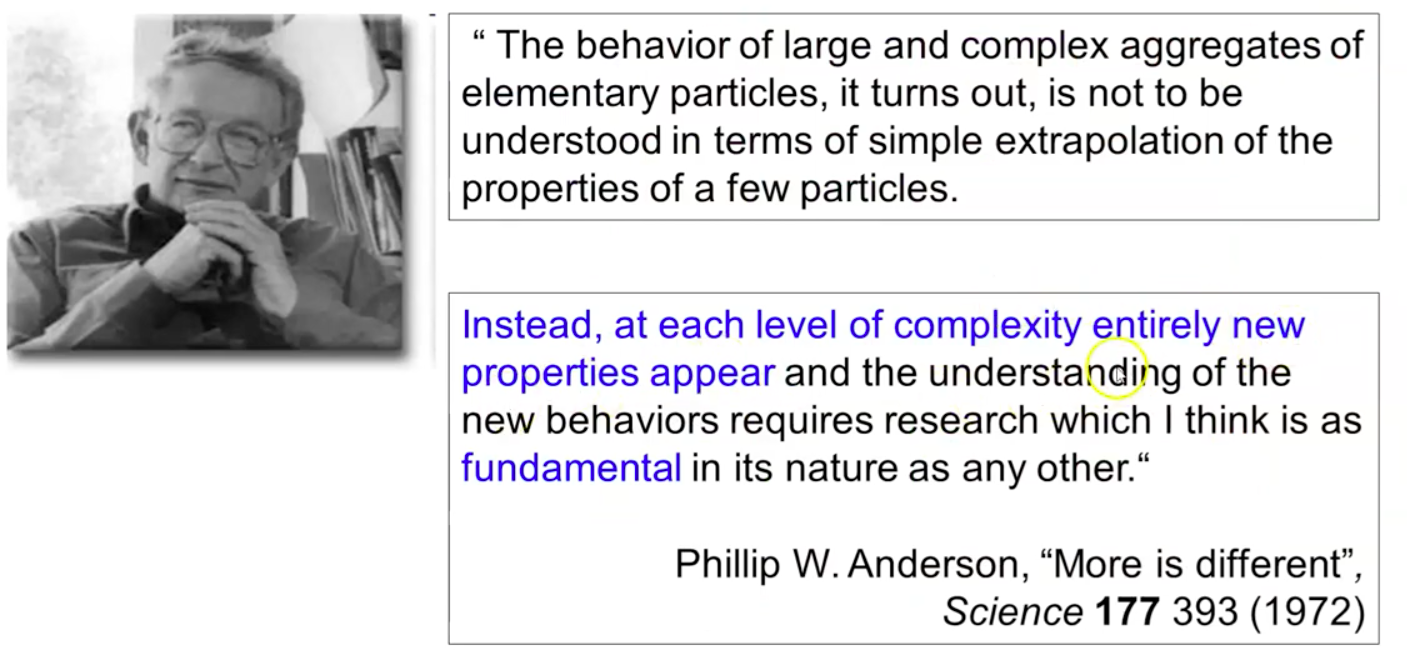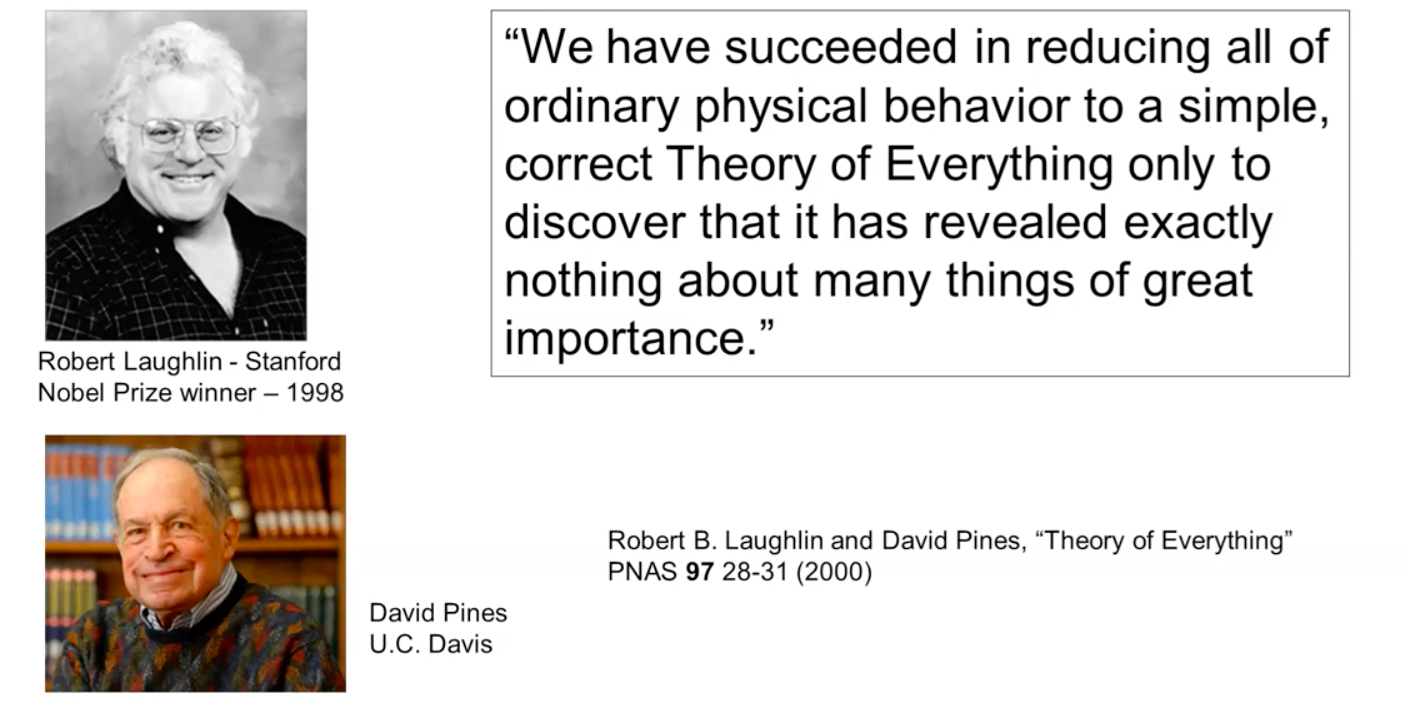The Legacy of Anderson's More is Different
More is Different by Philip W. Anderson
In 1972, the legendary physicist Philip W. Anderson, Nobel Laureate in Physics (1977), published an influential article in Science 1 titled “More Is Different”, offering a profound critique of reductionism in physics and arguing for the fundamental significance of emergent phenomena in complex systems. Anderson, a towering figure in condensed matter physics and often regarded as the father of modern quantum condensed matter theory, challenged the assumption—held by many both inside and outside science—that understanding the universe at its most fundamental level reduces to knowing the basic laws of quantum mechanics and relativity i.e, the reductionist paradigm that dominated much of 20th-century science.

Mediocrity is not a specter. It is a very real threat.

The Reductionism Fallacy
At the heart of classical reductionism lies the belief that all physical phenomena can ultimately be understood by breaking matter down into its most elementary constituents, thus by dissecting a system into its smallest constituents, one can eventually comprehend its full behavior. This philosophy has long underpinned the scientific method, guiding physicists to explore elementary particles, quarks, and ultimately the fundamental forces of nature. Atoms, protons, neutrons, electrons, and quarks—all obey the fundamental laws of Quantum Mechanics and Relativity. In principle, by knowing these laws, one should be able to reconstruct the universe’s complex behavior.
However, Anderson draws a clear distinction between reductionism and constructivism. The latter refers to the ability to reconstruct complex phenomena by simply applying fundamental laws. This is not feasible due to the intractable nature of the many-body problem, which Nobel laureate Robert B. Laughlin later emphasised:
“For many particle systems, nothing can be calculated exactly from the microscopic equations.”
The crux of the issue is scale and complexity. Macroscopic systems exhibit broken symmetry—phenomena not apparent from their microscopic laws. For example, while the fundamental equations governing atoms are symmetric, phase transitions lead to emergent structures like crystals or magnetic domains where this symmetry is broken. Thus, the symmetry of a given phase of matter may be different from that of the underlying microscopic equations due to symmetry breaking across phase transitions. The macroscopic behavior cannot be deduced solely by scaling up the microscopic laws. Knowing the Schrödinger equation
\[\hat{H}\Psi = E\Psi\]for individual particles doesn’t enable us to predict macroscopic phenomena like superconductivity, magnetism. For example, we know that water is made of molecules, molecules are made of atoms, atoms are made of electrons, protons, neutrons, protons, neutrons are made of quarks, quarks are made of strings, and $\dots$ so on, but we are unable to answer why water is wet or why is it transparent. Thus, reductionism does not imply constructivism. So we do require a different big picture to study such physical properties.
The Many-Body Problem and Emergence
One of the key insights in Anderson’s argument is the many-body problem:
For large systems, exact solutions from microscopic laws are generally intractable.
This leads to the emergence of new physical laws that cannot be derived by a simple summation of microscopic behavior. Nobel Laureate Robert Laughlin further emphasizes that broken symmetry plays a fundamental role in emergent properties. For example:
- A crystal breaks continuous translational and rotational symmetry into discrete lattice symmetry.
- Magnetism emerges as a collective ordering of spins, despite the fundamental rotational symmetry of individual electron spins.
An important concept is universality—many systems share the same emergent behavior regardless of microscopic differences.
Consider the classic Hamiltonian of a free electron in a magnetic field $\mathbf{B} = B \hat{z}$:
\[\hat{H} = \frac{1}{2m} \left( \mathbf{p} + e\mathbf{A} \right)^2\]This leads to the quantization of energy into Landau levels:
\[E_n = \hbar \omega_c \left( n + \frac{1}{2} \right) + \frac{\hbar^2 k_z^2}{2m}\]But understanding how such discrete energy levels manifest in transport phenomena like the Quantum Hall Effect requires treating the system as a whole, not as isolated particles.

Ice, Water, Ising Model and DNA.
One of the key insights Anderson presents is that large assemblies of elementary particles manifest novel, emergent properties that are not predictable from the properties of a few particles alone. These emergent laws are fundamentally independent of the microscopic details, and their discovery requires creativity, intuition, and new theoretical frameworks.
For instance, consider the quantum state of a macroscopic solid. While quantum mechanics predicts that the system exists in a superposition of all possible symmetry states (analogous to Schrödinger’s cat), in practice, the system becomes “locked” in a particular symmetry state. The energy barrier to quantum tunneling between different symmetry states becomes so enormous that the time scale vastly exceeds the age of the universe.
Mathematically, this can be expressed in terms of the tunneling amplitude $A \sim e^{-S/\hbar}$, where $S$ is the action associated with the transition between symmetry states. As $S$ grows with the number of particles $N$, the amplitude becomes effectively zero:
\[A \sim e^{-\alpha N}\]where $\alpha$ is a constant related to the energy barrier per particle.
Therefore, rather than being trivial consequences of microscopic laws, emergent phenomena like phase transitions, superconductivity, and magnetism require their own independent principles of understanding.
The Emergent Laws of Condensed Matter
Anderson’s bold proclamation was that at every new level of complexity, new laws, concepts, and generalizations arise—each demanding independent investigation. For instance:
- Symmetry considerations in particle physics point to homogeneous, isotropic space, yet solid crystals exhibit lattice periodicity breaking those symmetries.
- Quantum tunneling between symmetry-broken states is so slow (longer than the universe’s age) that macroscopically, these states are effectively stable.
Thus, macroscopic systems behave in ways that aren’t obvious extrapolations of microscopic laws. Instead, they exhibit emergent phenomena with their own governing principles.

Why Study Condensed Matter Physics?
Anderson argued that condensed matter physics is far from “less fundamental”; in fact, it covers about one-third of all physics knowledge. He challenged physicists to abandon the narrow reductionist approach and embrace the study of complexity, scale, and emergent behavior.
Anderson stresses that condensed matter physics, often overlooked as “applied” or “less fundamental”, is in fact as deep and essential as any study of elementary particles. It encompasses a vast range of phenomena—estimated by physicist Steve Simon to account for roughly one-third of all physics research.
A simple thought experiment illustrates the point: If one were to ask every physicist in the world to list the fundamental problems they study, a significant portion would focus on condensed matter systems—solid-state physics, superconductivity, quantum Hall effects, and so on.
The study of condensed matter reveals that the laws governing emergent macroscopic phenomena are as “fundamental” as those of quantum mechanics or relativity, not derivative or secondary. They require independent theoretical frameworks, often involving broken symmetries, order parameters, and novel collective behaviors.
A Thought Experiment
Imagine asking every physicist around the world:
What is the most fundamental aspect of matter?
Most would point to particles and quantum fields. Yet, Anderson shows that phenomena like superconductivity, magnetism, and topological phases aren’t just the sum of particles—they are governed by entirely new organizing principles.
Legacy, Impact and The Philosophical Shift
Anderson’s central thesis challenges the conventional reductionist dogma and redirects attention to the emergent complexity of nature. The behavior of complex, many-body systems cannot be deduced by extrapolating from microscopic laws alone. Instead, entirely new concepts, mathematical tools, and experimental techniques must be invented at each hierarchical level of complexity.
In the words of Anderson himself:
“At each new stage of complexity, entirely new laws, concepts, and generalizations are necessary.”
“More is Different” remains a profound call to physicists to look beyond microscopic laws and seek the organizing principles that govern complex systems. Anderson’s vision laid the foundation for topological phases of matter, quantum information, and even neuroscience-inspired models of computation. His article remains a foundational manifesto for condensed matter physicists and stands as a philosophical pivot, emphasizing that “more is different” is not just a catchy phrase, but a profound scientific insight into the hierarchy of natural laws.
Recommended Reading & Resources
For deeper insights, I highly recommend:
- David Tong’s lecture series: Cambridge Quantum Field Theory Lectures
- Robert Laughlin’s Nobel Lecture (1998)
- Philip W. Anderson (1923–2020), Intellectual giant of condensed matter physics
Philip W. Anderson, father of modern condensed matter physics - In memory of Philip W. Anderson., Wiersma, D.S., van Tiggelen, B.A. & Lagendijk, A. Nat. Photonics 14, 401–402 (2020). DOI:10.1038/s41566-020-0655-4
-
More Is Different: Broken symmetry and the nature of the hierarchical structure of science. Science, 4 Aug 1972, Vol 177, Issue 4047, pp. 393-396, DOI: 10.1126/science.177.4047.393 ↩
Enjoy Reading This Article?
Here are some more articles you might like to read next: